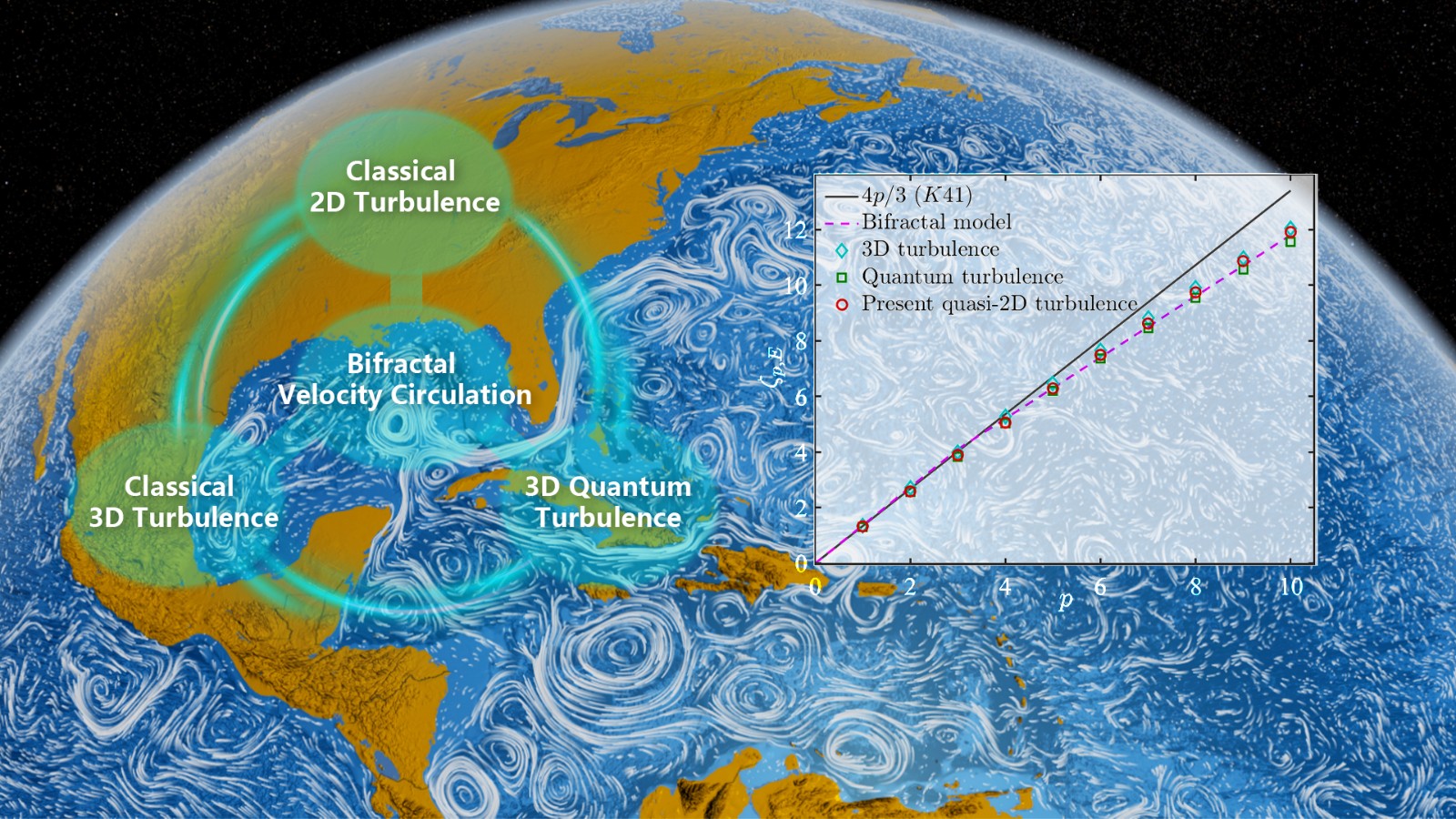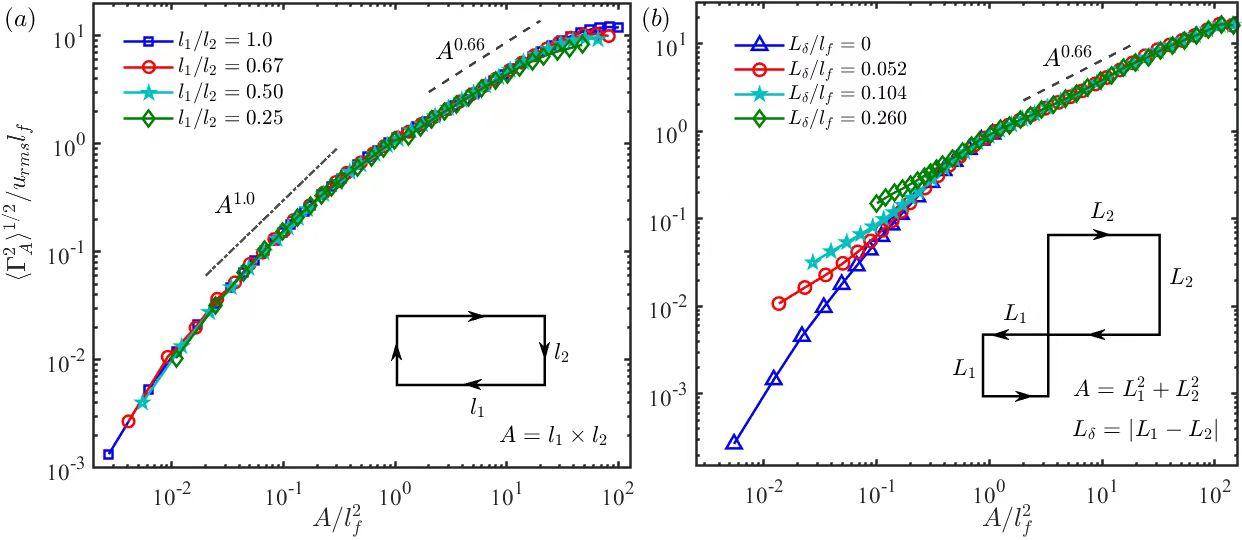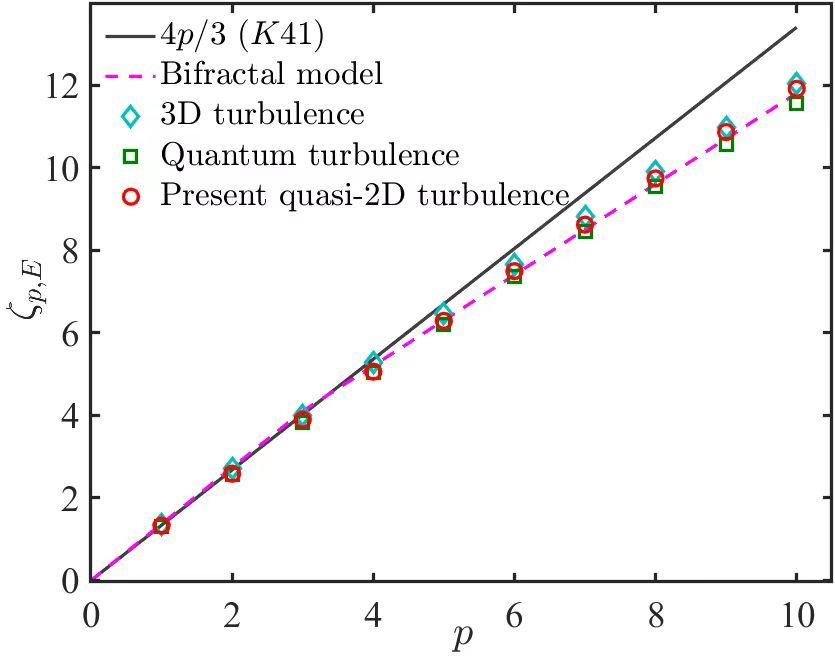Researchers experimentally reveal bifractal circulation in turbulence
2023-06-01
A major issue in the study of turbulence is to find its putatively universal small-scale properties. Most existing theories of turbulence based on phenomenology and mathematical analysis largely focus on the velocity structure functions, as their scaling laws can characterize the dynamics of energy cascade. However, due to the intermittency effect, the scalings exhibit multifractality (i.e., a nonlinear function of moment order), which is difficult to understand analytically.
This problem is further aggravated as high-order longitudinal and transverse structure functions scale differently. This difficulty motivates the community to seek other theoretical metrics that may be used to describe turbulence in a simpler way. A recent numerical study of high-Re 3D turbulence suggests that the circulation may be such an object, which is simpler than velocity itself: Circulation in the inertial range is bifractal and satisfies the area rule. Circulation was also found numerically to be a bifractal in quantum turbulence despite the distinct difference of vortex distributions in quantum and classical turbulence, which connects the intermittency in the two types of turbulence.

In collaboration with Dr. Jin-Han Xie of Peking University (PKU), Professor Ke-Qing Xia’s research group from the Center for Complex Flows and Soft Matter Research and the Department of Mechanics and Aerospace Engineering at the Southern University of Science and Technology (SUSTech) has recently made new findings in their study of circulation properties in quasi-2D turbulence.
Their research, entitled “Circulation in Quasi-2D Turbulence: Experimental Observation of the Area Rule and Bifractality”, has been published in Physical Review Letters, one of the most prestigious journals in the field of physics.
Recent experiments in 2D quantum turbulence observed the coherent vortex dynamics and condensates, as in classical 2D turbulence. Classical 2D turbulence is also closely related to physical processes for large-scale motions in geophysical flows. There exist essential differences between 2D and 3D turbulence, such as the conserved quantities, the direction of energy transfer, and the degree of intermittency in terms of velocity increments, which hinder the establishment of a unified theory of turbulence. Thus, it is highly desirable to find a single physical quantity that has the same (or similar) characteristics in both 2D and 3D turbulence, which, in turn, may afford us a more universal description of turbulence. The bifractality and area rule have not been observed experimentally so far in both 3D and 2D turbulence. Moreover, the study of circulation in 2D turbulence is made more interesting by its two IRs for energy and enstrophy cascades.
Prof. Xia’s group designed delicately experiments on quasi-2D turbulence driven electromagnetically. A conducting fluid of NaOH water solution is floated on a heavier, immiscible, dielectric fluid layer, FC-770. A direct current is driven through the top layer with copper electrodes at each end of the reservoir. Beneath the reservoir is a square matrix of 30×30 grade N52 magnets. The resulting Lorenz forces from the interaction between the current and the vertical magnetic field generate a vortex lattice in the top fluid that evolves to turbulent flows, as shown in Figure 1.

Figure 1. Instantaneous vorticity field: (a) Vortex lattice at the initial stage of the flow field; (b) Quasi-two-dimensional turbulence in the stable stage of the flow field
They found that for simple loops (i.e., rectangles, Figure 2a), the area rule of circulation is applicable in both inertial ranges, as shown in Figure 2a. However, for more complex loops (such as the figure-eight loop), the area rule only holds in the energy-inverse-cascade inertial range and is not applicable in the enstrophy-forward-cascade inertial range, as shown in Figure 2b. Furthermore, the circulation is found to exhibit no intermittency in the enstrophy forward cascade inertial range and presents bifractality in the energy-inverse-cascade inertial range (as shown in Figure 3), while the velocity increments present a close-to-multifractal behavior in the energy-inverse-cascade inertial range. The characteristic parameters obtained from the fitting of bifractal circulation in their experiment were perfectly consistent with the theoretical derivation.

Figure 2. The second-order circulation structure function as a function of length scales for different shapes of integral loops: (a) Simple loops; (b) figure-eight loops
That the bifractality is found in both the energy inverse cascade of 2D turbulence and the energy forward cascade of 3D turbulence indicates that this property may be independent of the direction of energy transfer. Thus, these results are relevant to geophysical flows where cascades in both directions exist. Moreover, a bifractal circulation is much simpler in terms of analysis and understanding than the multifractal velocity and could lead to a reduction in the complexity of the loop-space reformulation of the Navier-Stokes equations. The elusive intermittency effect in different types of turbulence, i.e., 3D classical turbulence, quasi-2D classical turbulence, and 3D quantum turbulence, can be manifested more simply by circulation. It may, therefore, serve as a potential theoretical metric for a unified description of turbulence.

Figure 3. Bifractal circulation observed in different types of turbulence
Hang-Yu Zhu, a postdoctoral fellow of Prof. Ke-Qing Xia’s group, is the first author of the paper. Prof. Ke-Qing Xia is the corresponding author, and Dr. Jin-Han Xie from PKU is the co-author.
This research was supported by the National Natural Science Foundation of China (NSFC) and the China Postdoctoral Science Foundation.
Paper link: https://doi.org/10.1103/PhysRevLett.130.214001




